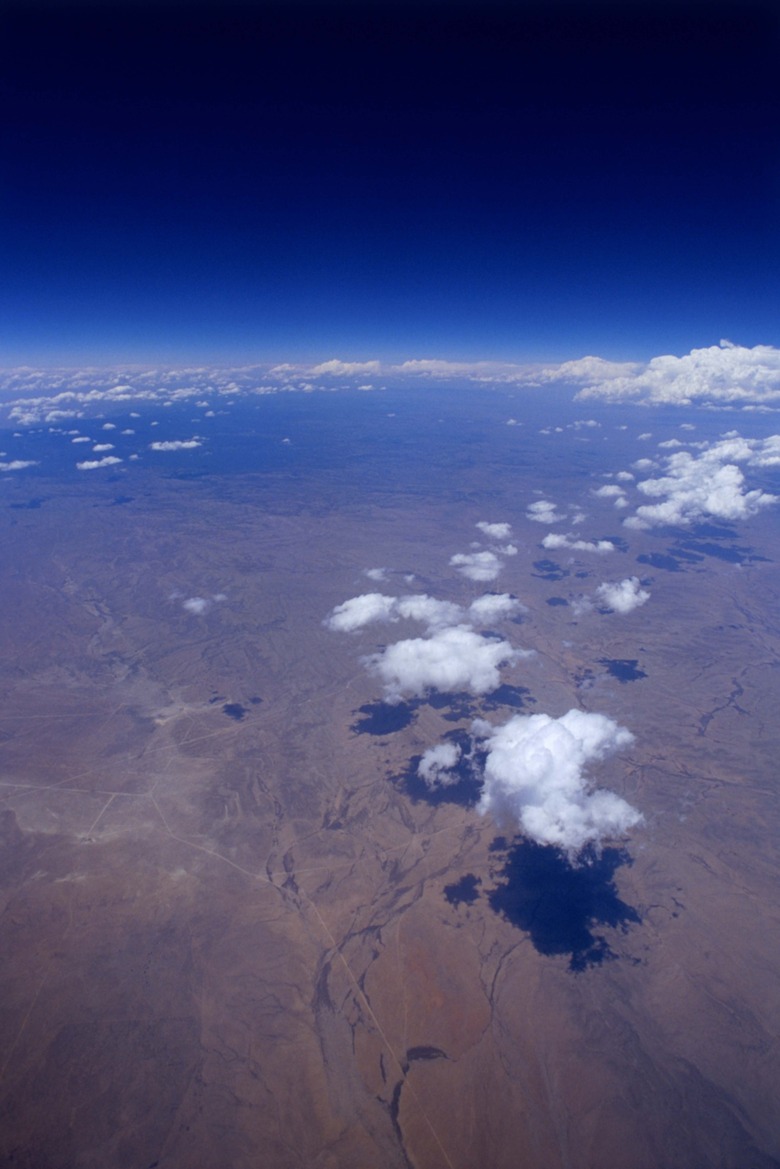Importance Of The Earth's Atmosphere
Without the protective layer of gases that make up Earth's atmosphere, the harsh conditions of the solar system would render the planet a barren, lifeless husk like the moon. The Earth's atmosphere protects and sustains the planet's inhabitants by providing warmth and absorbing harmful solar rays. In addition to containing the oxygen and carbon dioxide, which living things need to survive, the atmosphere traps the sun's energy and wards off many of the dangers of space.
Temperature
Temperature
One of the most important benefits the atmosphere provides is maintaining the Earth's temperature. On the moon, which has no protective atmosphere, temperatures can range from 121 degrees Celsius in the sun (250 degrees Fahrenheit) to negative 157 degrees Celsius in the shade (negative 250 degrees Fahrenheit). On Earth, however, molecules in the atmosphere absorb the sun's energy as it arrives, spreading that warmth across the planet. The molecules also trap reflected energy from the surface, preventing the night side of the planet from becoming too cold.
Radiation
Radiation
The atmosphere serves as a protective shield against radiation and cosmic rays. The sun bombards the solar system with ultraviolet radiation, and without protection, that radiation can cause severe damage to skin and eyes. The ozone layer high in the Earth's atmosphere blocks much of this radiation from reaching the surface. Dense layers of molecular gases also absorb cosmic rays, gamma rays and x-rays, preventing these energetic particles from striking living things and causing mutations and other genetic damage. Even during a solar flare, which can greatly increase the damaging output of the sun, the atmosphere is able to block most of the harmful effects.
Physical Protection
Physical Protection
The solar system may seem like a vast and empty place, but in reality it is full of debris and small particles leftover from planetary creation or collisions in the asteroid belt. According to NASA, more than 100 tons of space debris strikes Earth every single day, mostly in the form of dust and tiny particles. When they encounter the molecules that make up Earth's atmosphere, however, the resulting friction destroys them long before they reach the ground. Even larger meteors can break up due to the stresses of atmospheric re-entry, making catastrophic meteor strikes an incredibly rare occurrence. Without the physical protection of the atmosphere, the surface of the Earth would resemble that of the moon, pockmarked with impact craters.
Weather and Water
Weather and Water
The atmosphere also serves an important purpose as a medium for the movement of water. Vapor evaporates out of oceans, condenses as it cools and falls as rain, providing life-giving moisture to otherwise dry areas of the continents. According to the U.S. Geological Survey, the Earth's atmosphere holds around 12,900 cubic kilometers (3,100 cubic miles) worth of water at any given time. Without an atmosphere, it would simply boil away into space, or remain frozen in pockets below the surface of the planet.
References
- NASA: Goddard Space Flight Center: Moon Facts
- NASA: Goddard Space Flight Center: Danger of Solar and Cosmic Radiation in Space
- Environmental Protection Agency: UV Radiation
- NASA: Asteroid and Comet Watch
- NASA: Jet Propulsion Laboratory: Near Earth Object Program
- U.S. Geological Survey: The Water Cycle
Cite This Article
MLA
Kazmeyer, Milton. "Importance Of The Earth's Atmosphere" sciencing.com, https://www.sciencing.com/importance-earths-atmosphere-5070/. 13 March 2018.
APA
Kazmeyer, Milton. (2018, March 13). Importance Of The Earth's Atmosphere. sciencing.com. Retrieved from https://www.sciencing.com/importance-earths-atmosphere-5070/
Chicago
Kazmeyer, Milton. Importance Of The Earth's Atmosphere last modified March 24, 2022. https://www.sciencing.com/importance-earths-atmosphere-5070/
